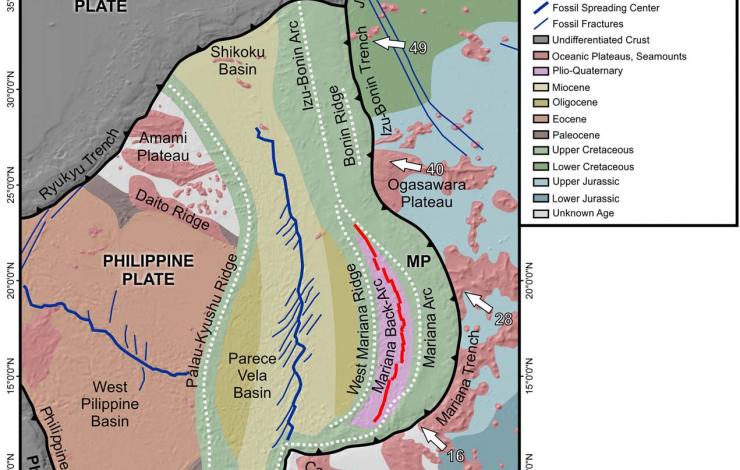Anderson, M.O., W.W. Chadwick, Jr., M.D. Hannington, S.G. Merle, J.A. Resing, E.T. Baker, D.A. Butterfield, S.L. Walker, and N. Augustin
Geochem. Geophys. Geosyst., 18(6), 2240–2274, doi: 10.1002/2017GC006813 (2017)
The relationships between tectonic processes, magmatism, and hydrothermal venting along
600 km of the slow-spreading Mariana back-arc between 12.78N and 18.38N reveal a number of similarities
and differences compared to slow-spreading mid-ocean ridges. Analysis of the volcanic geomorphology
and structure highlights the complexity of the back-arc spreading center. Here, ridge
segmentation is controlled by large-scale basement structures that appear to predate back-arc rifting.
These structures also control the orientation of the chains of cross-arc volcanoes that characterize this
region. Segment-scale faulting is oriented perpendicular to the spreading direction, allowing precise
spreading directions to be determined. Four morphologically distinct segment types are identified: dominantly
magmatic segments (Type I); magmatic segments currently undergoing tectonic extension (Type
II); dominantly tectonic segments (Type III); and tectonic segments currently undergoing magmatic
extension (Type IV). Variations in axial morphology (including eruption styles, neovolcanic eruption volumes,
and faulting) reflect magma supply, which is locally enhanced by cross-arc volcanism associated
with N-S compression along the 16.58N and 17.08N segments. In contrast, cross-arc seismicity is associated
with N-S extension and increased faulting along the 14.58N segment, with structures that are interpreted
to be oceanic core complexes—the first with high-resolution bathymetry described in an active
back-arc basin. Hydrothermal venting associated with recent magmatism has been discovered along all
segment types.



